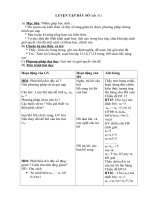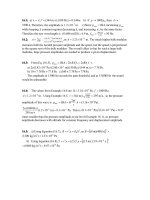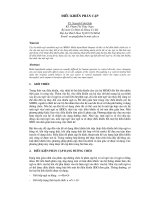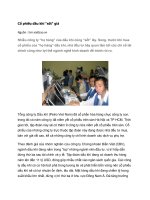Tài liệu Field-E ect (FET) transistors ppt
Bạn đang xem bản rút gọn của tài liệu. Xem và tải ngay bản đầy đủ của tài liệu tại đây (668.71 KB, 14 trang )
Field-Effect (FET) transistors
References: Hayes & Horowitz (pp 142-162 and 244-266),
Rizzoni (chapters 8 & 9)
In a field-effect transistor (FET), the width of a conducting channel in a semiconductor and,
therefore, its current-carrying capability, is varied by the application of an electric field (thus,
the name field-effect transistor). As such, a FET is a “voltage-controlled” device. The most
widely used FETs are Metal-Oxide-Semiconductor FETs (or MOSFET). MOSFET can be
manufactured as enhancement-type or depletion-type MOSFETs. Another type of FET is
the Junction Field-Effect Transistors (JFET) which is not based on metal-oxide fabrication
technique. FETs in each of these three categories can be fabricated either as a n-channel
device or a p-channel device. As transistors in these 6 FET categories behave in a very
similar fashion, we will focus below on the operation of enhancement MOSFETs that are
the most popular.
n-Channel Enhancement-Type MOSFET (NMOS)
The physical structure of a n-Channel Enhancement-Type MOSFET (NMOS) is shown.
The device is fabricated on a p-type substrate (or Body). Two heavily doped n-type re-
gions (Source and Drain) are created in the substrate. A thin (fraction of micron) layer
of SiO
2
, which is an excellent electrical insulator, is deposited between source and drain
region. Metal is deposited on the insulator to form the Gate of the device (thus, metal-oxide
semiconductor). Metal contacts are also made to the source, drain, and body region.
To see the operation of a NMOS, let’s ground the source and the body and apply a voltage
v
GS
between the gate and the source, as is shown above. This voltage repels the holes in
the p-type substrate near the gate region, lowering the concentration of the holes. As v
GS
increases, hole concentration decreases, and the region near gate behaves progressively more
like intrinsic semiconductor material (excess hole concentration zero) and then, finally, like
ECE60L Lecture Notes, Spring 2002 61
a n-type material as electrons from n
+
electrodes (source and drain) enter this region. As a
result, when v
GS
become larger than a threshold voltage, V
t
, a narrow layer between source
and drain regions is created that is populated with n-type charges (see figure). The thickness
of this channel is controlled by the applied v
GS
(it is really controlled by v
GS
− V
t
).
As can be seen, this device works as a channel is induced in the semiconductor and this
channel contains n-type charges (thus, n-channel MOSFET). In addition, increasing v
GS
increases channel width (enhances it). Therefore, this is an Enhancement-type MOSFET.
Now for a given values of v
GS
> V
t
(so
that the channel is formed), let’s apply
a small and positive voltage v
DS
between
drain and source. Then, electrons from n
+
source region enter the channel and reach
the drain. If v
DS
is increased, current i
D
flowing through the channel increases. Ef-
fectively, the device acts like a resistor; its
resistance is set by the dimension of the
channel and its n-type charge concentra-
tion. In this regime, plot of i
D
versus
v
DS
is a straight line (for a given values
of v
GS
> V
t
) as is shown.
The slope of i
D
versus v
DS
line is the conductance of the channel. Changing the value of
v
GS
, changes dimension of the channel and its n-type charge concentration and, therefore,
its conductance. As a result, changing v
GS
, affects the the slope of i
D
versus v
DS
line as is
shown above (at cut-off conductance is zero and conductance increases with v
GS
− V
t
).
The above description is correct for small
values of v
DS
as in that case, v
GD
= v
GS
−
v
DS
≈ v
GS
and the induced channel is
fairly uniform (i.e., has the same width
near the drain as it has near the source).
For a given v
GS
> V
t
, if we now increase
v
DS
, v
GD
= v
GS
− v
DS
becomes smaller
than v
GS
. As such the size of channel near
drain becomes smaller compared to its size
near the source, as is shown. As the size
of channel become smaller, its resistance
increases and the curve of i
D
versus v
DS
starts to roll over, as is shown below.
ECE60L Lecture Notes, Spring 2002 62
For values of v
GD
= V
t
(or v
DS
= v
GS
− V
t
), width of the channel approaches zero near the
drain (channel is “pinched” off). Increasing v
DS
beyond this value has little effect (no effect
in our simple picture) on the channel shape, and the current through the channel remains
constant at the value reached when v
DS
= v
GS
− V
t
. So when the channel is pinched off, i
D
only depends on v
GS
(right figure below).
NMOS Characteristic Curves Plot of i
D
versus v
GS
in the active regime
In sum, a FET can operate in three regimes:
1) Cut-off regime in which no channel exists (v
GS
< V
t
for NMOS) and i
D
= 0 for any v
DS
.
2) Ohmic or Triode regime in which the channel is formed and not pinched off (v
GS
> V
t
and v
DS
≤ v
GS
− V
t
for NMOS) and FET behaves as a “voltage-controlled” resistor.
3) Active or Saturation regime in which the channel is pinched off (v
GS
≥ V
t
and v
DS
>
v
GS
− V
t
for NMOS) and i
D
does not change with v
DS
.
Several important point should be noted. First, no current flows into the gate, i
G
= 0
(note the insulator between gate and the body). Second, FET acts as a “voltage-controlled”
resistor in the ohmic region. In addition, when v
DS
v
GS
, FET would act as a linear
resistor. Third, If i
D
= 0, this does not mean that FET is in cut-off. FET is in cut-off when
a channel does not exist (v
GS
< V
t
) and i
D
= 0 for any applied v
DS
. On the other hand,
FET can be in ohmic region, i.e., a channel is formed, but i
D
= 0 because v
DS
= 0. Lastly,
the third regime is called “saturation” in most electronic books because i
D
is “saturated” in
this regime and does not increase further. This is a rather unfortunate name as “saturation”
regime in a FET means very different thing than it does in a BJT. Some newer books call
this regime “active” (as it equivalent to “active-linear” regime of a BJT). Note that the
ECE60L Lecture Notes, Spring 2002 63
transition between ohmic and active region is clearly defined by v
DS
= v
GS
− V
t
the point
where the channel is pinched off.
The i
D
versus v
DS
characteristic curves of a FET look very similar to i
C
versus v
CE
char-
acteristics curves of a BJT. In fact, as there is a unique relationship between i
B
and v
BE
,
the i
C
versus v
CE
characteristic curves of a BJT can be “labeled” with different values of
v
BE
instead of i
B
making the characteristic curves of the two devices even more similar. In
FET v
GS
control device behavior and in BJT v
BE
. Both devices are in cut-off when the
“input” voltage is below a threshold value: v
BE
< v
γ
for BJT and v
GS
< V
t
for NMOS. They
exhibit an “active” regime in which the “output” current (i
C
or i
D
) is roughly constant as
the “output” voltage (v
CE
or v
DS
) is changed. There are, however, major differences. Most
importantly, a BJT requires i
B
to operate but in a FET i
G
= 0 (actually very small). These
differences become clearer as we explore FETs.
G
B
S
D
G
S
D
i
D
i
D
G
S
D
As can be seen from NMOS physical structure,
the device is symmetric, that is position of drain
and source can be replaced without any change in
device properties. The circuit symbol for a NMOS
is shown on the right. For most applications, how-
ever, the body is connected to the source, leading
to a 3-terminal element. In that case, source and
drain are not interchangeable. A simplified circuit
symbol for this configuration is usually used. By
convention, current i
D
flows into the drain for a
NMOS (see figure). As i
G
= 0, the same current
will flow out of the source.
Direction of “arrows” used to identify semiconductor types in a transistor may appear con-
fusing. The arrows do NOT represent the direction of current flow in the device. Rather,
they denote the direction of the underlying pn junction. For a NMOS, the arrow is placed
on the body and pointing inward as the body is made of p-type material. (Arrow is not
on source or drain as they are interchangeable.) In the simplified symbol for the case when
body and source is connected, arrow is on the source (device is not symmetric now) and is
pointing outward as the source is made of n-type materials. (i.,e. arrow pointing inward for
p-type, arrow pointing outward for n-type).
ECE60L Lecture Notes, Spring 2002 64
NMOS i
D
versus v
DS
Characteristics Equations
Like BJT, a NMOS (with source connected to body) has six parameters (three voltages and
three currents), two of which (i
S
and v
GD
) can be found in terms of the other four by KVL
and KCL. NMOS is simpler than BJT because i
G
= 0 (and i
S
= i
D
). Therefore, three
parameters describe behavior of a NMOS (v
GS
, i
D
, and v
DS
). NMOS has one characteristics
equation that relates these three parameters. Again, situation is simpler than BJT as simple
but accurate characteristics equations exist.
Cut-off: v
GS
< V
t
, i
D
= 0 for any v
DS
Ohmic: v
GS
> V
t
, i
D
= K[2v
DS
(v
GS
− V
t
) − v
2
DS
] for v
DS
< v
GS
− V
t
Active: v
GS
> V
t
, i
D
= K(v
GS
− V
t
)
2
for v
DS
> v
GS
− V
t
Where K is a constant that depends on manufacturing of the NMOS. As mentioned above,
for small values of v
DS
, NMOS behaves as resistor. r
DS
, and the value of r
DS
is controlled
by v
GS
− V
t
. This can be seen by dropping v
2
DS
in i
D
equation of ohmic regime:
r
DS
=
v
DS
i
D
≈
1
2K(v
GS
− V
t
)
How to Solve NMOS Circuits:
Solution method is very similar to BJT circuit (actually simpler because i
G
= 0). To solve,
we assume that NMOS is in a particular state, use NMOS model for that state to solve the
circuit and check the validity of our assumption by checking the inequalities in the model
for that state. A formal procedure is:
1) Write down a KVL including the GS terminals (call it GS-KVL).
2) Write down a KVL including DS terminals (call it DS-KVL).
3) From GS-KVL, compute v
GS
(using i
G
= 0)
3a) If v
GS
< V
t
, NMOS is in cut-off. Let i
D
= 0, solve for v
DS
from DS-KVL. We are done.
3b) If v
GS
> V
t
, NMOS is not in cut-off. Go to step 4.
4) Assume NMOS is in active region. Compute i
D
from i
D
= K(v
GS
− V
t
)
2
. Then, use
DS-KVL to compute v
DS
. If v
DS
> v
GS
− V
t
, we are done. Otherwise go to step 5.
5) NMOS has to be in ohmic region. Substitute for i
D
from i
D
= K[2v
DS
(v
GS
− V
t
) − v
2
DS
]
in DS-KVL. You will get a quadratic equation in v
DS
. Find v
DS
(one of the two roots of the
equation will be unphysical). Check to make sure that v
DS
< v
GS
− V
t
. Substitute v
DS
in
DS-KVL to find i
D
.
ECE60L Lecture Notes, Spring 2002 65









